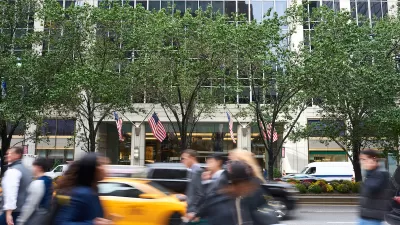Paris and New York City are two of the world's more successful pedestrian cities, with each boasting several kinds of data that show the predominance of alternative transportation. An article compares public space in each for lessons.

"In Paris, where I hail from, 60% of journeys are by foot - far beyond car trips (7%) – and 60% of Parisians do not own a car," writes Clémence Morlet, and in New York City, "53% of those who live and work in Manhattan never use a car, bus, subway or train in their everyday trips but instead walk, ride a bicycle or motorcycle, take a taxicab, or work at home."
Given the large population of pedestrians making use of the public spaces in these cities, Morlet asks, "How do they support this large pedestrian population and decrease auto-dominance in public space?"
In Paris, for instance, the Pedestrian Paris Initiative has been "shifting the focus from other modes of transportation to pedestrians." That includes clearing sidewalks of obstacles as well as widening sidewalks. Moreover, "The municipal government has also focused on creating a balance in the street between motorized vehicles, public transportation, bikes, and pedestrians, in part by implementing lower speed limit areas."
As for New York, according to Morlet, "New York City has implemented complete-streets roadway design that accommodates all users: pedestrians, people on bikes, and drivers," citing the New York City Department Transporttion efforts like the 2008 report World Class Streets: Remaking New York City’s Public Realm and the 2009 Street Design Manual. Among other case studies, Morlet examines the success of the 59 public plazas created by NYC DOT since 2007: "Post-project surveys show the plazas are mainly supported by New Yorkers (up to 72%) and 76% of New Yorkers live now within ten minutes of open space (up from 70 in 2007). Moreover, the improvements generally resulted in an increase in retail sales at locally-based businesses; like in Pearl Street in Brooklyn where local retail sales have increased by 172%, compared to 18% borough-wide."
FULL STORY: Shared Space and Slow Zones: Comparing Public Space in Paris and New York

Alabama: Trump Terminates Settlements for Black Communities Harmed By Raw Sewage
Trump deemed the landmark civil rights agreement “illegal DEI and environmental justice policy.”

Planetizen Federal Action Tracker
A weekly monitor of how Trump’s orders and actions are impacting planners and planning in America.

The 120 Year Old Tiny Home Villages That Sheltered San Francisco’s Earthquake Refugees
More than a century ago, San Francisco mobilized to house thousands of residents displaced by the 1906 earthquake. Could their strategy offer a model for the present?

In Both Crashes and Crime, Public Transportation is Far Safer than Driving
Contrary to popular assumptions, public transportation has far lower crash and crime rates than automobile travel. For safer communities, improve and encourage transit travel.

Report: Zoning Reforms Should Complement Nashville’s Ambitious Transit Plan
Without reform, restrictive zoning codes will limit the impact of the city’s planned transit expansion and could exclude some of the residents who depend on transit the most.

Judge Orders Release of Frozen IRA, IIJA Funding
The decision is a victory for environmental groups who charged that freezing funds for critical infrastructure and disaster response programs caused “real and irreparable harm” to communities.
Urban Design for Planners 1: Software Tools
This six-course series explores essential urban design concepts using open source software and equips planners with the tools they need to participate fully in the urban design process.
Planning for Universal Design
Learn the tools for implementing Universal Design in planning regulations.
Clanton & Associates, Inc.
Jessamine County Fiscal Court
Institute for Housing and Urban Development Studies (IHS)
City of Grandview
Harvard GSD Executive Education
Toledo-Lucas County Plan Commissions
Salt Lake City
NYU Wagner Graduate School of Public Service




























